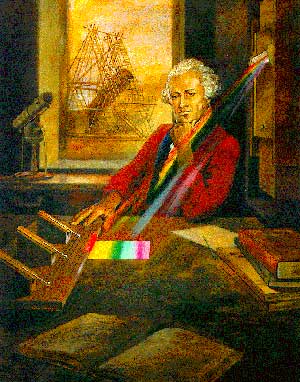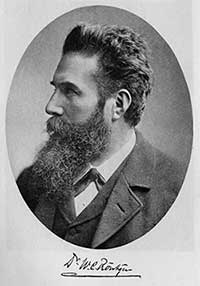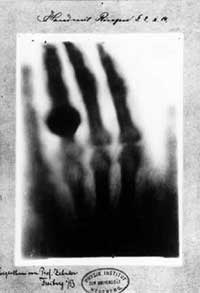Discovering the Electromagnetic Spectrum
Discovering the Electromagnetic Spectrum

Portrait of Sir William Herschel, pictured with the experiment that enabled him to discover infrared light. (Credit: NASA/IPAC)
How do you discover light that your eyes can't see? Serendipity. In the year 1800, Sir William Herschel was exploring the question of how much heat was contained by the different colors of visible light. He devised and experiment where he used a glass prism to separate sunlight into it's rainbow of colors. Then, he placed a thermometer under each color, with one extra thermometer just beyond the red light of the spectrum. He found that the thermometer that was seemingly out of the light had the highest temperature. Thus, he discovered infrared light.
A year later, Johann Wilhelm Ritter was inspired by Herschel's discovery to see if there might be light just beyond the purple end of the spectrum. Indeed, there was, and Ritter discovered ultraviolet light. In 1867, James Clerk Maxwell predicted that there should be light with even longer wavelengths than infrared light. In 1887 Heinrich Hertz demonstrated the existence of the waves predicted by Maxwell by producing radio waves in his laboratory.
It took a bit longer for scientists to discover the higher-energy (shorter wavelength) light in the electromagnetic spectrum.


Left: Portrait of Wilhelm Conrad Röntgen who is credited with discovering X-rays. Right: Mrs. Röntgen's hand, the first X-ray picture of the human body ever taken.
X-rays were first observed and documented in 1895 by Wilhelm Conrad Röntgen, a German scientist who found them quite by accident when experimenting with vacuum tubes. A week after he first observed them, he took an X-ray photograph of his wife's hand, which clearly revealed her wedding ring and her bones. The photograph electrified the general public and aroused great scientific interest in the new form of radiation. Röntgen called it "X" to indicate it was an unknown type of radiation. The name stuck, although many of his colleagues suggested calling them Röntgen rays.
While Röntgen first observed the effects of X-rays in 1895, it wasn't until 1912 that scientists were able to conclude that they were, indeed, another form of light."
Gamma-rays were first observed in 1900 by Paul Villard when he was investigating radiation from radium. A few years later, Ernest Rutherford proposed the name "gamma-rays," for this new radiation, and the name stuck. Like X-rays, the exact nature of gamma-rays took a little while for scientists to work out. In 1914, when Rutherford observed that they could be reflected off the layers of a crystal, it was clear that they were akin to X-rays (in other words another form of light), but with much shorter wavelengths.
Updated: September 2013
